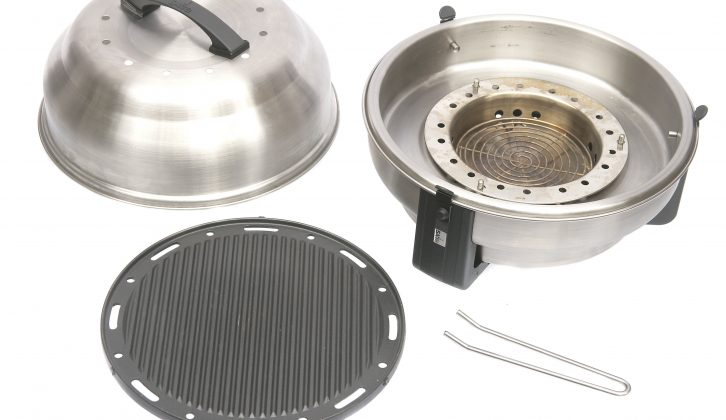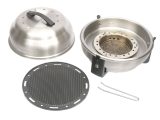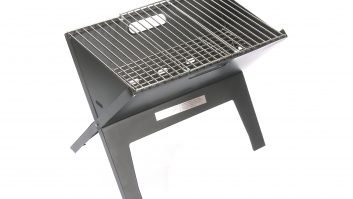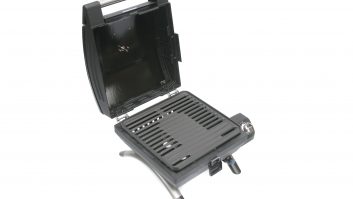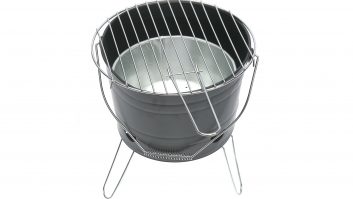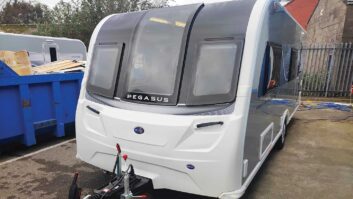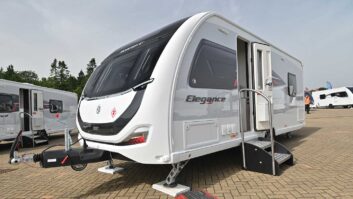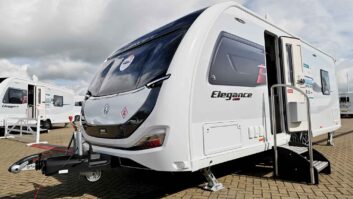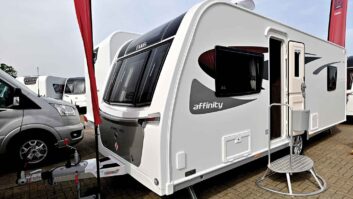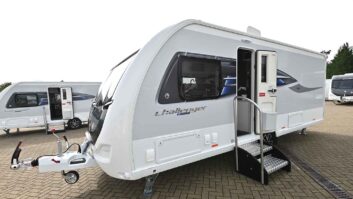Verdict
The Olpro SAfire is a well designed and versatile portable charcoal barbecue and we’ve awarded it a four-star rating.
Pros
Versatile BBQ and slow cooker
Strong
Clever design
Fairly compact for this grill area
Cons
No temperature indicator
Not much change from £100
If you live in a hot, dry climate, designing and making barbecues for sale must seem like a pretty good business plan. So we’re not surprised to discover that South Africa-based Olpro has produced one of the most exciting barbecues to grace the Practical Caravan test bench this year.
When is a barbecue not a barbecue? Perhaps when it’s Olpro’s SAfire, which excels as a barbecue, a grill and even a slow cooker, all of which are fuelled by charcoal. This is achieved thanks to a two-sided grill plate that allows normal barbecue cooking if you have it one way up, or baking and frying if you place it the other way up. There’s a reservoir that collects liquid fat as it runs off your sausages, so that it won’t flare up or drip onto the floor. There’s a lid, so that you can use it as a small camp oven, too. This would be handy in windy conditions, so that you won’t get ash and sparks flying out.
It’s hard not to be impressed by the overall sturdy construction, and the way that all the components slot together. And, while this isn’t the smallest or lightest product to store (the pack-down size is 35cm in diameter by 35cm high), it’s still reasonably compact given the generous cooking area provided by the 30cm-diameter top grille.
Our only minor whinge is that, unlike other oven models we tested, this one doesn’t have a temperature indicator.
The price of the SAfire, £94.99, puts it towards the top end of our price range for this group barbecue test. We’ve also reviewed the brilliant Weber Go Anywhere gas barbecue at £103, the compact charcoal-burning Quest Folding BBQ at £21.99, the lidded charcoal-burning Bodum Fyrkat costing £50, the Campingaz 1 Series Compact EX CV at £95.95 and the Outwell Cazal, at a budget-friendly £19.99, and the SunnCamp Deluxe Bucket BBQ at £14.95.
Practical Caravan tests camping accessories regularly to help you buy the best camping gear to take on holiday. If you’re buying a new barbecue for caravan holidays anytime soon, one of the first questions to ask yourself is whether you need it to be fuelled by charcoal and wood or by gas. There are pros and cons of each type. For instance, if you mainly like touring in southern Europe you may find that charcoal barbecues are banned on most campsites due to the risk of starting a wildfire. So for crispy dry climates, we’d recommend that you should focus mainly on comparing portable gas grills.
Gas BBQ grills are perfect if you’re in a hurry, too. They tend to heat up pretty instantly, create little mess and no ash. They’re easy to clean, and they’ll cool down swiftly after the meal, so that you can pack them away before bedtime. With gas, you could even cook your breakfast on the barbecue on the last day of your holiday, secure in the knowledge that it will be cool enough to pack away by the time you leave the site.
On the other hand, in Britain we can often get away with cooking on charcoal and wood, even if some campsites stipulate that you use a metal stand, or pile of bricks, to make sure that you don’t damage the grass. We’ve checked the distance between the bottom of each barbecue we tested and the floor, to assess the risk of setting fire to your surroundings on site.
Charcoal barbecues are slow to get going, they drop ash onto the grass and they need a good clean after use – but many people still love them. We have to admit that the best BBQ flavours on a steak come from the smoke and slightly burnt edges that you only get when you cook with fire. You can add apple wood, pear wood or hickory to the flames for even more flavour.
So, whichever cooking method you choose, check out our latest BBQ reviews and star ratings before you make up your mind which product to buy.
When is a barbecue not a barbecue? Perhaps when it’s Olpro’s SAfire
Technical Specifications
| Pack size | 35cm diameter x 35cm high |
| Fuel | Charcoal briquettes |
| Economy | 300g charcoal gives 2.5 hours of roasting |
| Weight | 3.5kg |
| Two-sided grill plate | BBQ side and an oven/frying side |
